Cost of games

I recently spoke in Anaheim (California) with the report "Industry Lifecycles" . It was planned that this would be a short presentation of my blog posting with a small portion of material from another of my recent publications about the game economy . She made quite a bit of noise. There were discussions at the forums, in which skepticism was often expressed regarding the data presented by me and the conclusions made. Initially, the article was a response to comments on various sites, which I collected in the form of questions and answers. That is, I did not rely on a single study.
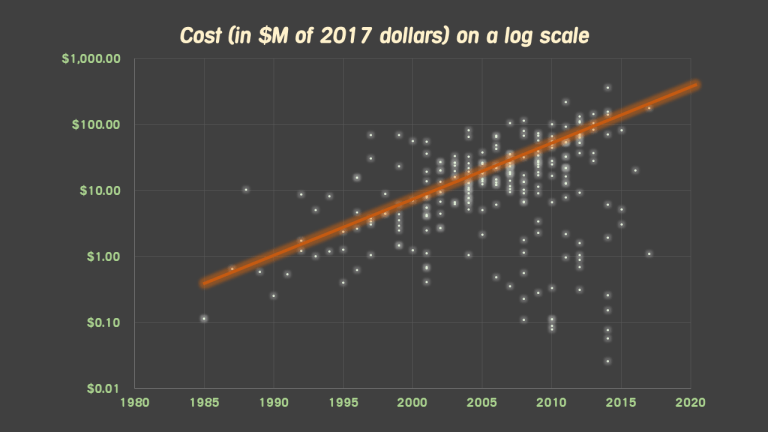
As many have noted, it is difficult to collect reliable data on the cost of games. When in 2005 I was preparing the report “Moore's Wall” , I conducted a simple study using mostly open data, extrapolated the exponential cost curve of games and warned that, in my opinion, these are inevitable trends. But since then, much has changed, not least because of two completely new business models invented in the past tense.
So my performance on Casual Connect has turned into an updated version of Moore's Wall. Using professional connections and conducting research on the network, I collected a data set from more than 250 games covering several decades . I want to share my discoveries, telling about them in more detail, than I managed to do in 25 minutes of performance. Here are all the slides, but this article - a deeper analysis of the same data.
For each game there is a declared development cost , which - this is important - does not include marketing expenses . So for the most part it is the cost of salaries and overhead costs, for example on tools. If the values were given in other currencies (euro, yen, zloty), then I converted to dollars at the rate that prevailed in December of the year when the particular game was released. Then I took all the dollar values and adjusted for inflation so that I could compare it directly with modern game budgets.
Here's what happened:

As you can see, reading on the graph is not so easy, because the vast majority of games cost less than $ 50 million. Only the console and PC games of the AAA category, which have huge budgets, are knocked out, and you have probably heard about them, because a lot of money is spent on their promotion.
If you plot on a logarithmic scale, then it will become much easier to read. Here, each horizontal means an increase in costs by 10 times.

The dynamics of the value of AAA games is obvious. It can be seen that since about 1995 (there is too little information about earlier years) every 10 years their value grows 10 times . Do not forget, this data is already taking into account inflation.
The appearance of indie games and mobile games is also clearly visible. According to them, there are much fewer points on the graph, and a staggering amount was released altogether with virtually no budget. Moreover, almost all of them were unprofitable. Most of the mobile games on the chart are successful at least nominally.

I calculated the average cost for the year and plotted its changes, but these data speak only about the contribution of AAA games, which have a strong influence on the average annual indicators. So I will not go into this schedule. I note only the lack of the freshest and oldest data. I must also say that several recent mobile games have a budget of $ 5 to $ 20 million — that is, the lower limit of the range for AAA games is quite high. Even licked indie PC games can cost several millions.
In general, taking into account reporting (it is more interesting to discuss insane expenses) and the exponential difference of budgets, the median schedule, i.e. the “typical game” schedule, does not change in this ratio. And given the lack of data on mobile and indie games in dataset, these averaged data as a whole are certainly overstated . Perhaps this will console someone, especially if you are currently working on an AAA game worth $ 50 million.
On the other hand, the picture is too optimistic: after all, marketing expenses are not taken into account. Rule of thumb: AAA-games marketing budget is approximately 75-100% of the development budget . So the cost of shipping an AAA game into the hands of buyers is likely to double. In the mobile segment, you can often hear that experienced salespeople invest in marketing from three to ten development budgets due to market overcrowding.
If we analyze the data more closely, then in the indie and mobile segments, there is also a tendency to increase costs. This is not surprising, since as the market develops, the cost of production increases. But the question arises, is it possible to somehow compare one with the other in order to assess global trends? After all, let budgets grow if profits and audiences grow at the same pace, right? We will understand along the way.
I decided to look for some correlating information. For example, something related to the computing power or describing the "steps" on the graph. And did not find. And finally came to a very simple comparison - to bytes. I analyzed the actual installation size , disk space (or device) after installation, as well as all the additional downloadable and streaming patches.
As you understand, the resulting data also had to be postponed on logarithmic graphics, because the old games were only a few kilobytes in size, and the newest games were in tens of gigabytes.
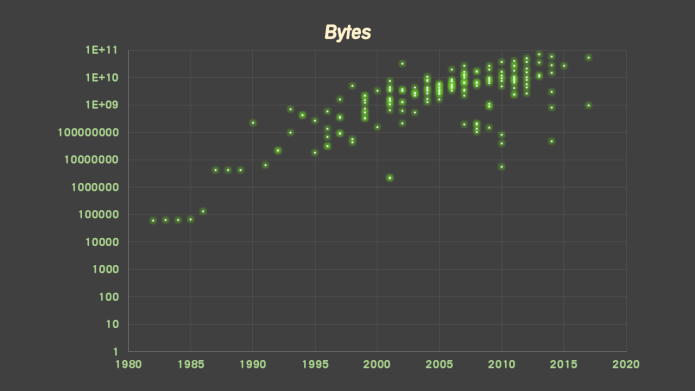
To my surprise, the growth in the size of games did not correlate with the release of platforms, even at the height of console wars. Sometime in the middle of the life cycle of consoles, additional memory modules went on sale, and later new unpacking techniques appeared during execution that allowed storing even more data on disks. For example, the NXE update for Xbox 360 using compression techniques reduces the installation size by 30%. Given the various streaming downloads that are not cached , many games require an active connection. So the sizes of games given here, unlike budgets, are rather underestimated .
Anyway, now we have some kind of reference point. How many dollars does the developer spend on one byte? We expect a fall in unit cost. In my first speech, “Moore's Wall”, I analyzed total and unit costs from 1985 to 2005 and came to a simple conclusion (which I repeated in several subsequent performances, including Age of the Dinosaurs ): the size of the games increased 122 times, expenses - 22 times, which means that the efficiency of creating games has grown 6 times.
Here is the specific cost of a byte on a logarithmic scale:

But it turned out that during the year the specific cost of different games can vary by 10 times, and this is true for most of the analyzed period. Having studied some specific meanings, I can say that most of them are affected by whether the game depends on the content (content-driven) or on the system (system-driven). In a narrative game with a bunch of resources, such as an RPG, the specific cost will be higher. There are also several well-known examples in dataset when game development was very difficult, and they are expected to be at the upper limit of unit costs in their years.
But the real discovery was that indie games for $ 5 million and giant AAA-cross-platform monsters for $ 100 million for megabytes turned out to be the same cost (although these games had a nose). Probably, the reason is that within the industry salaries are little dependent on the segments.
Having plotted the average unit cost, I saw that we were on a plateau.
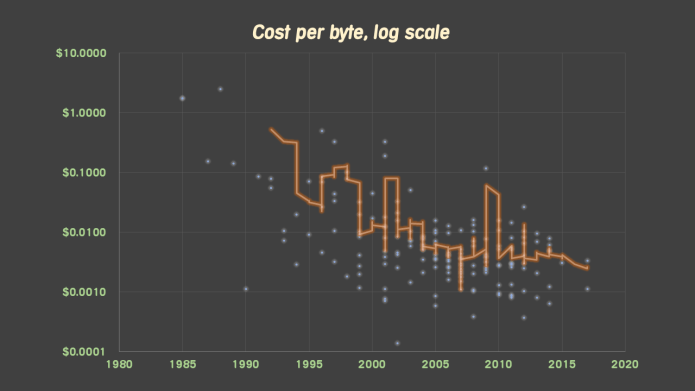
Unreal Engine 3 and Unity came out in 2004-2005th. I thought that these two amazing engines would greatly reduce the specific cost. But they, apparently, stabilized it.
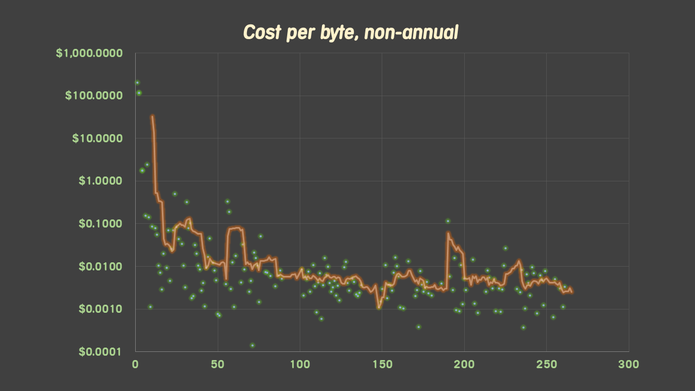
The conclusion is that, perhaps, the standardization of one of the two engines hinders rapid innovation in cost-effective development techniques. I do not know how else to explain the alignment of the graph. Perhaps the reason is that Unity and Unreal are designed around static data pipelines and have little ability to work with procedural data? Or maybe stabilization is a blessing and the specific cost should start to grow? I do not know. I even expanded the average annual values and simply sorted the games by year of release, trying to find the ones that led to the alignment of the schedule.
Games have a high complexity of data, and it seems to me that the players underestimate this very much. A good illustration of my thesis . It describes how the creation of one game character in 1997 took 10 working days, and the creation of another in 2007 - 35 working days. The author believes that creating a character today takes hundreds of days. If earlier, for something, textures of 256 × 256 pixels were used, now several textures of 4096 × 4096 are used for visibility maps, relief maps, substitution maps, etc.
But let's look at the situation differently, because the real challenge is whether we, the developers, can cover the cost of expenses? I went through the dataset and put in, where I could, recommended retail prices for inflation. For mobile games with a one-time payment, I chose old prices, for old MMOs - the cost of the boxed version + semi-annual subscription, where it was possible, I also inserted the real life cycle of the game for users. As a result, I calculated how much money the players paid for the megabytes of the game over the past years.

You can say, “Wait! We pay not for megabytes, but for pleasure! We pay for the gameplay! And not for the installation! We pay for the value of the games !!! ”Yes, yes. But in practice, the cost of development correlates with bytes, and not with the rating on Metacritic (I did not build such a schedule, but I was easily convinced of this visually, and it’s obvious that a big bad game will be expensive).
Many noted ( 1 , 2 , 3 , 4 , 5 , 6 ) that in terms of solvency, players pay about half as much as in the 1980s . You can thank for this the good old inflation. This is well shown on the chart here . And from the point of view of the bytes, players pay far less than double.
What games bring high unit revenues? These are "evergreen" games that bet:
- on the community
- user generated content
- on the skill of the players (as in sports).
It is not surprising that most games in the upper range are MMO and online service games. They are probably not as cool as it seems, since there are still games that are heavily dependent on the loaded content, but for MMO I tried to compensate for this by adding data on the total size on the disk after the game, which includes all cached loads.
The highlight is that it greatly underestimates the decline in the cost of games , because today entire segments of the gaming industry distribute games for free . Games with the free to play model take up a lot of bytes on the devices of users who simply do not pay. And yes, some whales then pay so much that it covers the shortfall from the "free" players. But in order for the resulting data to be equivalent to the unit cost for AAA games of the same size, it is necessary that during the whole life of the game each player should spend $ 60 in it . Average. As you understand, “free” players are unlikely to pay an average of $ 60 (although some pay, especially in Asia).
And this is not to mention other aspects that reduce profits, such as a gradual decrease in sales prices, sales of packages or sales on Steam.
I will be absolutely honest: I have absolutely no data on cost, installation dimensions and typical profits in the mobile segment. So for now this is quite speculative. But I do not like the shape of this curve, especially in comparison with the schedule of development costs.
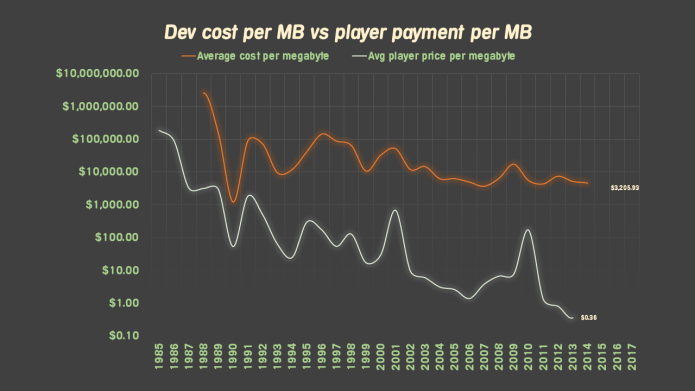
As you can see, the graphics do not match. Worse, this is a logarithmic scale, so the gap accelerates every year . The classic “mass production” scenario. We, as an industry, can allow players to pay less and less as long as we sell games to more and more users.
But ... at least in developed countries, the situation is close to saturating the market . There is the term “total addressable market”, which means “everyone you can sell to”. We crossed the bar "50% of people are players" almost eight years ago. In marketing, there is a rule that the farther a person is from your target audience, the more expensive it is to achieve - that is, the deeper we penetrate various segments of users, the more you have to spend on marketing. And remember: in all these charts, marketing expenses are not counted .
According to current trends, I can make some naive predictions by simply attaching a ruler to the monitor:

First prediction: at a pace in about ten years, the average game will become free. And since dataset is built with a bias in AAA games, I mean the average AAA game. Some games will pay you to play them. No matter how insane it may seem, I would like to note that this already occurs very often in free to play games, which, we believe, did not beat off what was spent - we paid for the development and marketing, you played, and the costs are not covered.
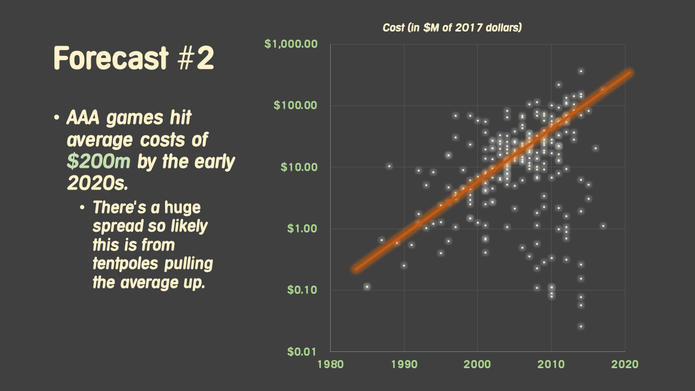
Second forecast: top AAAA products will carry off the average cost of AAA. Developing a terabyte of game in the early 2020s will cost $ 250 million.
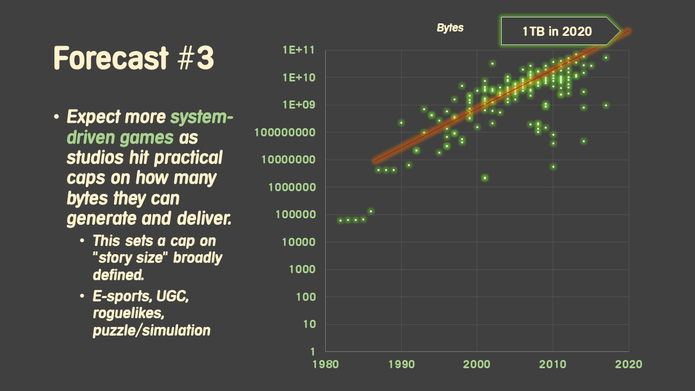
We must not forget that for the most part we are talking about the cost of technology development. While technologies are developing exponentially, so will the costs, especially if we continue to use our tools naively.
By “naively” I mean pixelation.
There are some ways to improve this curve . They are all complicated. Most methods have not been applied consistently and effectively throughout the history of computer games, and, frankly, they are not very well given to us. But some games have proved to us that all these measures can work and change the graphics. In fact, they all do the same thing: instead of bytes, other types of content are paramount .
A strong community retains players , and retention contributes to profits. Perhaps building a community is the easiest of what developers should actively strive for, and this is not an expensive and not an easy task. I believe that the learning curve for the studio takes 3-5 years after changing the culture in the team.
Design taking into account the dynamic, rather than static content . This is bad news for many of my favorite games. Recently I liked What Remains of Edith Finch the most. I consider it an absolute masterpiece, combining the art of storytelling and other arts. But from a business point of view, I am curious whether such games with static content will be viable in the next decade.
Emphasis on multiplayer mode , because players effectively generate the game value for each other. Difficulties are the same as building a community.
Changing our emphasis on the free to play model , which now involves generating small amounts of content and encouraging players to buy it. This download of content can ruin us.
You also need to encourage users to generate bytes in different ways. UGC, using your own models, customization - whatever.
Algorithmic and procedural approaches need to be used MUCH more widely. Fortunately, in this we are far ahead of the academic community , and there are already studies on the generation of entire games in the code. Yes, in the long run, you, as developers, may become obsolete, but at least publishers will live and raise glasses in memory of you, feeding your brains to educational networks for their neural network AI developers.
By the way, your servers are terribly inefficient . From the point of view of a veteran MMO, you probably do not fully use processors because of their libraries, containers, virtual machines, virtualization, and network stack. Imagine that you need to host 5,000 copies of your online RPG on a Pentium 1999 release. This is possible. This may change the schedule.
Price increase is the most obvious solution. No one wants that. It will probably happen anyway.
Or you can go on the other side and do less games .
Appeal to the players: I know you do not like all of the above . Believe me, many of this does not like the developers themselves. If you want to save your favorite games, then you can help: do not use pirated versions, support developers with a ruble, do not crucify them in social networks and do not call them brainless greedy bastards, but first of all understand the situation.
And if you are a developer, then the best that I can advise ... this article is not true, and all these trends are in many ways a product of my opinion. So develop your skills and knowledge while you can .
- Think of the entire industry as a mature market. We are finishing transitions to new platforms, leading to lower costs.
- Be well versed in general design, design with an emphasis on retaining players, and community-based design. That is, think like an MMO developer. That is, design everything as if “game-as-service”.
- Take full advantage of procedural approaches.
- And also develop skills in branding and marketing, without them you will not survive. This market will become even closer.
, . ( ), -, free to play . ( ), ( ), . .
, , - , . . , , .
: , .
')
Source: https://habr.com/ru/post/347474/
All Articles